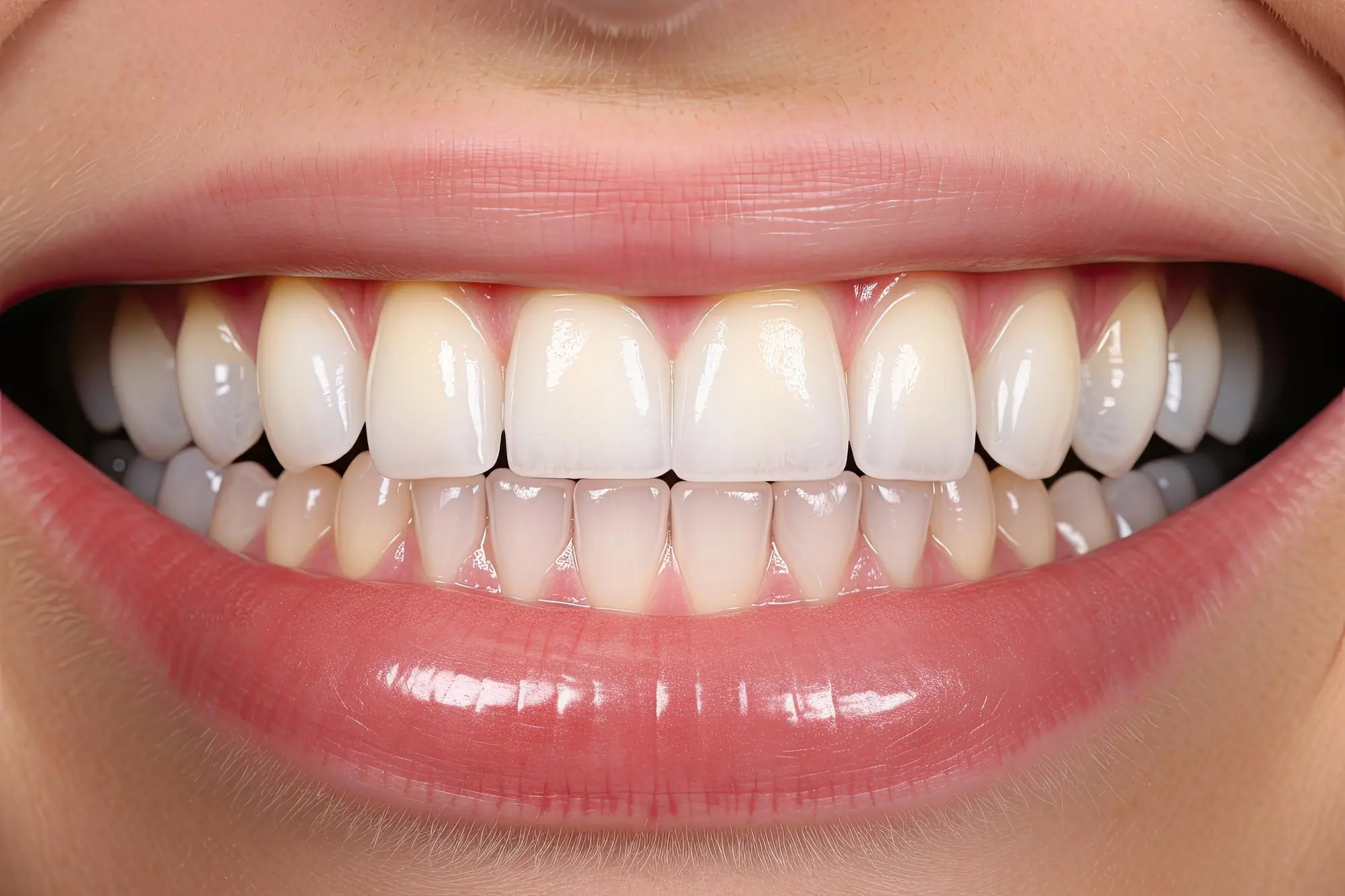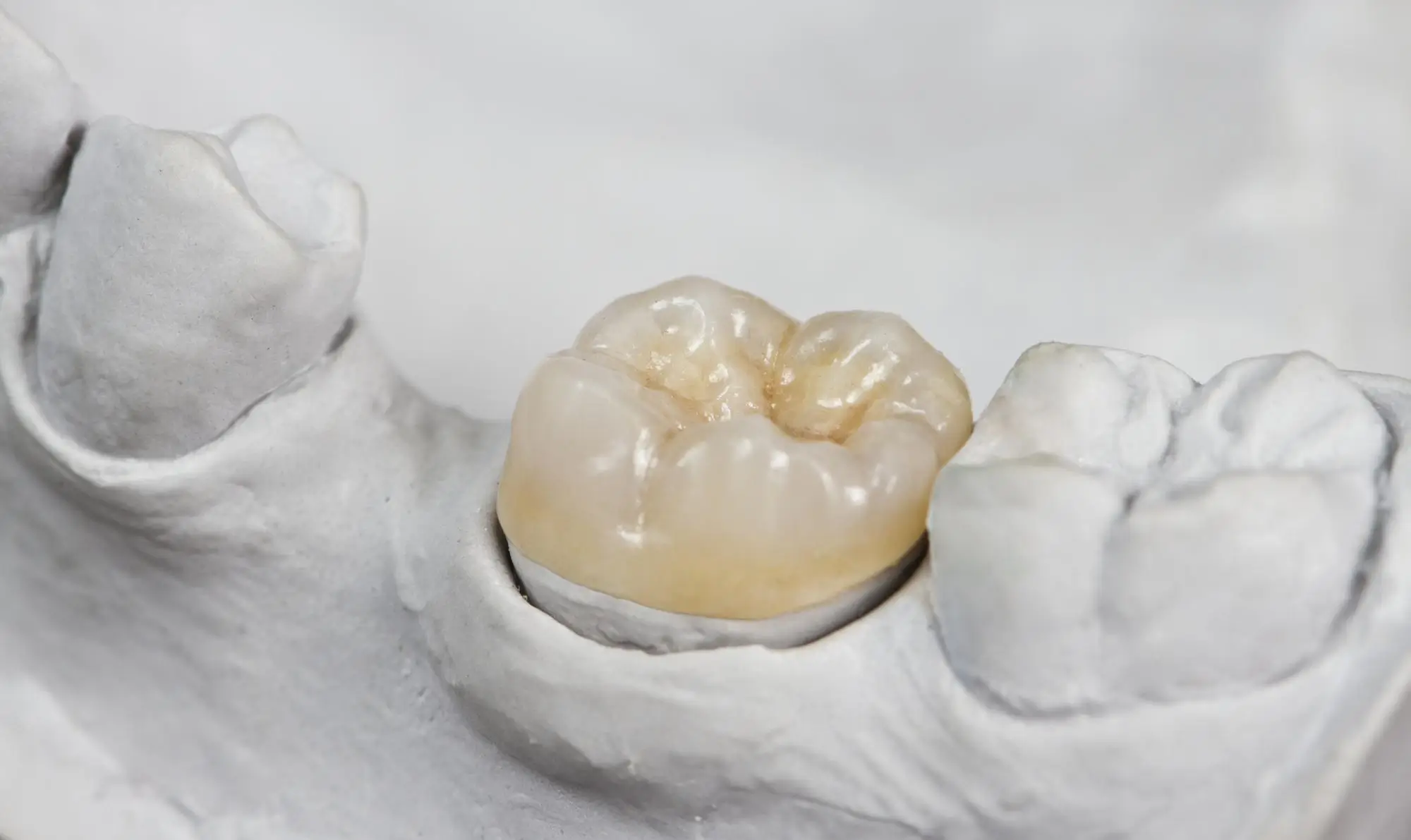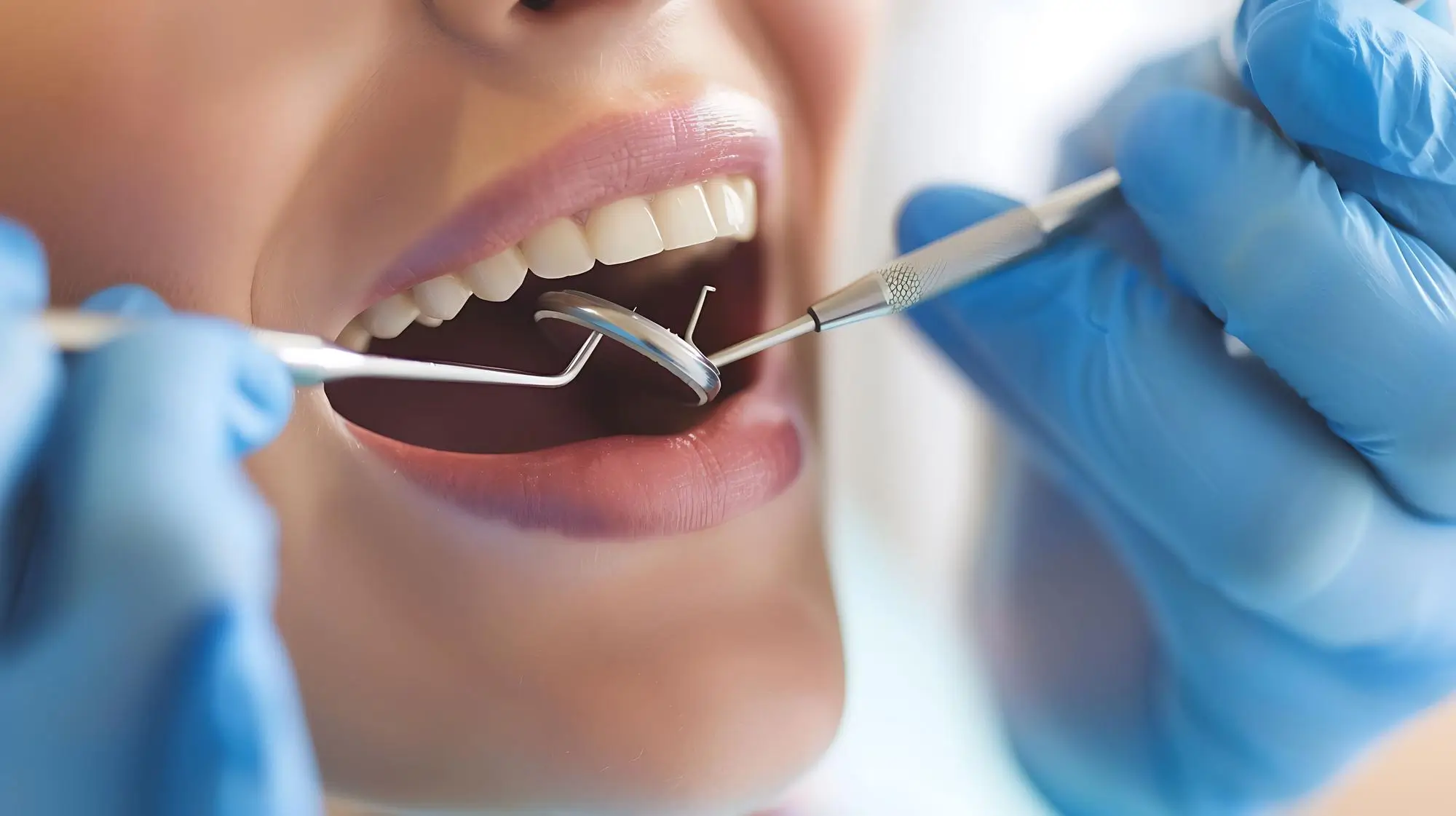Choosing between different dental onlay materials needs some research. In this post we will explore the pros and cons of onlay materials (ceramic onlays, composite resin onlays and gold alloy onlays). Also we will guide you through selecting and framing criteria for the best type of onlay material available for you.
Introducing Dental Onlays
Dental onlays (part of general dentistry) are crucial restorative solutions used in modern dentistry to repair damaged or decayed teeth effectively. Unlike dental fillings that are molded into place during a dental visit, onlays are fabricated in a dental laboratory based on impressions taken from the patient’s tooth. This customization ensures a precise fit and optimal function.
Purpose of Dental Onlays
The primary purpose of dental onlays is to restore the structural integrity of a tooth that has been compromised due to extensive decay, fracture, or other damage. Onlays cover more surface area of the tooth compared to fillings, extending over one or more of its cusps (projections). This feature allows onlays to provide greater strength and support to the tooth while preserving its natural structure and function.
If you want dental onlay sevices, you can contact us.
Role in Restorative Dentistry
In restorative dentistry, dental onlays play a vital role in preserving natural tooth structure and preventing further deterioration. They are considered conservative treatments because they require minimal removal of healthy tooth structure compared to dental crowns. This conservative approach helps maintain the strength and longevity of the remaining tooth while addressing significant damage or decay.
Types of Dental Onlays
Dental onlays are classified based on the material types used in their fabrication, each offering unique characteristics in terms of durability, aesthetics, and clinical performance. The choice of material depends on various factors, including the location of the restoration, functional requirements, patient preferences, and the dentist’s recommendation.
In the next section, we will explore the different types of dental onlay materials in detail, highlighting their advantages and considerations in restorative dentistry.
Types of Dental Onlay Materials
Dental onlays are available in different materials, each offering unique properties that influence their durability, aesthetics, and clinical performance. Choosing the right material for a dental onlay depends on factors such as the location of the restoration, functional requirements, patient preferences, and the dentist’s recommendation. This section provides an in-depth comparison of the most commonly used dental onlay types to help patients and dental professionals make informed decisions in restorative dentistry.
Ceramic Onlays
Ceramic onlays, also known as porcelain onlays, are popular for their natural appearance and durability. These onlays are fabricated from dental ceramics that closely mimic the translucency and shade variations of natural teeth. Here are key characteristics of ceramic onlays:
- Aesthetics:Ceramic onlays offer excellent aesthetic results due to their ability to blend seamlessly with natural tooth enamel. They can be customized in color and translucency to match adjacent teeth, making them ideal for restorations in visible areas of the mouth.
- Durability:Dental ceramics used in onlays are highly durable and resistant to wear. They provide strong, long-lasting restorations that withstand normal chewing forces without compromising aesthetics.
- Biocompatibility:Ceramic onlays are biocompatible and well-tolerated by gum tissues, minimizing the risk of allergic reactions or tissue irritation.
- Clinical Applications:Ceramic onlays are suitable for both anterior and posterior restorations, offering versatility in treating decayed or damaged teeth while preserving natural tooth structure.
Composite Resin Onlays
Composite resin onlays are made from tooth-colored composite materials that bond directly to the tooth surface. These types offer several advantages in dental restorations:
- Aesthetics:Composite resin onlays provide natural-looking results by closely matching the color and appearance of natural teeth. They can be shade-matched to blend seamlessly with surrounding dentition, enhancing smile aesthetics.
- Conservative Treatment:Composite resin onlays require minimal tooth preparation, preserving more natural tooth structure compared to traditional dental crowns.
- Versatility:Composite resin materials allow for direct bonding to the tooth structure, creating a strong and durable restoration that adapts well to functional and aesthetic requirements.
- Clinical Applications:Composite resin onlays are typically used in moderate to low stress-bearing areas of the mouth. They are suitable for restoring decayed or damaged teeth where aesthetics and conservative treatment are priorities.
Gold Alloy Onlays
Gold alloy onlays have been a staple in restorative dentistry for their exceptional durability and longevity. These onlays are crafted from gold alloys that offer unique benefits:
- Strength and Durability:Gold alloys used in onlays provide unmatched strength and durability, making them ideal for posterior restorations subjected to heavy chewing forces.
- Longevity:Gold alloy type of dental onlays are known for their longevity and minimal wear over time. They can withstand wear and tear while maintaining excellent marginal integrity.
- Biocompatibility:Gold alloys are biocompatible and well-tolerated by oral tissues, minimizing the risk of allergic reactions or adverse tissue responses.
- Clinical Applications:Gold alloy onlays are commonly used in posterior restorations where strength, durability, and long-term success are paramount. They require minimal tooth preparation and offer predictable clinical outcomes.
Read it: Biomimetic Materials in Dentistry
In the next part of this section, we will delve deeper into considerations such as cost-effectiveness, maintenance requirements, and patient satisfaction associated with each type of dental onlay material. This comprehensive comparison aims to provide a holistic understanding of material selection criteria and empower patients and dental professionals to make informed decisions in restorative dentistry.
Comparison of Dental Onlay Materials
Choosing the most suitable type of dental onlay material involves evaluating various factors beyond initial cost and aesthetic appeal. This section provides a detailed comparison of ceramic, composite resin, and gold alloy onlays, highlighting their unique characteristics and considerations in restorative dentistry.
Ceramic Onlays
Ceramic onlays are renowned for their natural appearance and durability, making them a popular choice in modern dentistry. Here’s how ceramic onlays compare across different criteria:
- Aesthetics:Ceramic onlays closely mimic the natural translucency and color variation of teeth, providing superior aesthetic results. They blend seamlessly with natural dentition, making them ideal for visible areas of the mouth.
- Durability:Dental ceramics used in onlays are highly resistant to wear and fracture, offering long-term durability comparable to natural teeth. Ceramic onlays maintain their strength and appearance over time with proper care.
- Biocompatibility:Ceramic materials are biocompatible and well-tolerated by oral tissues, minimizing the risk of allergic reactions or irritation. They promote healthy gum tissue integration and support long-term oral health.
- Clinical Applications:Ceramic onlays are versatile and suitable for both anterior and posterior restorations. They provide reliable solutions for restoring decayed or damaged teeth while preserving natural tooth structure.
Composite Resin Onlays
Composite resin onlays offer aesthetic appeal and functional durability, particularly in moderate stress-bearing areas of the mouth. Here’s how composite resin onlays compare:
- Aesthetics:Composite resin materials can be shade-matched to blend seamlessly with natural teeth, enhancing smile aesthetics. They provide excellent aesthetic results for visible restorations.
- Conservative Treatment:Composite resin onlays require minimal tooth preparation, preserving more natural tooth structure compared to crowns. This conservative approach supports long-term tooth health and integrity.
- Versatility:Composite resin materials bond directly to tooth structure, creating strong and durable restorations. They adapt well to functional demands and provide reliable performance in everyday use.
- Clinical Applications:Composite resin onlays are suitable for restoring moderate-sized cavities and defects in teeth. They offer versatility in treatment planning and can be customized for individual patient needs.
Gold Alloy Onlays
Gold alloy onlays are valued for their exceptional strength, longevity, and biocompatibility. Here’s how gold alloy compares in clinical practice:
- Strength and Durability:Gold alloys used in onlays provide unparalleled strength and durability, making them ideal for posterior restorations subjected to heavy chewing forces. They withstand wear and maintain integrity over time.
- Longevity:Gold alloy onlays are known for their longevity and minimal wear in clinical use. They offer reliable performance and require minimal maintenance compared to other materials.
- Biocompatibility:Gold alloys are biocompatible and well-accepted by oral tissues, reducing the risk of allergic reactions or adverse tissue responses. They promote healthy gum tissue integration and support long-term oral health.
- Clinical Applications:Gold alloy type of onlays are commonly used in posterior restorations where durability and longevity are critical. They provide predictable clinical outcomes and contribute to patient satisfaction with their reliable performance.
Considerations in Material Selection
Beyond clinical performance, several considerations influence the selection of dental onlay materials:
- Cost-effectiveness:The initial cost and long-term maintenance requirements vary among ceramic, composite resin, and gold alloy onlays. Factors such as material longevity and restoration complexity impact overall treatment costs.
- Maintenance Requirements:Each material type has unique maintenance needs that affect long-term oral health and restoration longevity. Regular dental visits and proper oral hygiene practices are essential for maintaining onlay integrity.
- Patient Satisfaction:Patient preferences for aesthetics, comfort, and durability play a significant role in material selection. Dentists collaborate with patients to choose the most suitable onlay material type based on individual needs and treatment goals.
Read it: Dental Inlay Material ComparisonAt Fortune Smiles Dental Care, we prioritize patient-centered care and offer personalized recommendations based on comprehensive assessments and treatment goals. Our experienced dental team considers factors such as patient preferences, clinical indications, and long-term oral health outcomes when selecting the most suitable dental onlay material.
In the next part of this section, we will explore emerging trends in types of dental onlay materials and technologies, as well as advancements shaping the future of restorative dentistry. This comprehensive comparison aims to provide a holistic understanding of material selection criteria and empower patients and dental professionals to make informed decisions in restorative dentistry.
Considerations at Fortune Smiles Dental Care
At Fortune Smiles Dental Care, we prioritize patient-centered care and offer personalized recommendations based on comprehensive assessments and treatment goals. Our experienced dental team considers factors such as patient preferences, clinical indications, and long-term oral health outcomes when selecting the most suitable dental onlay material.
Patient-Centered Approach
Our practice focuses on understanding each patient’s unique needs and expectations. We emphasize open communication and collaboration to ensure informed decision-making throughout the treatment process. By educating patients about their treatment options and discussing the benefits of different onlay materials, we empower them to make confident choices for their oral health.
Comprehensive Assessments
Before recommending a dental onlay types, our dental team conducts thorough assessments to evaluate the condition of the tooth, functional requirements, and aesthetic goals. We utilize advanced diagnostic tools and imaging technology to accurately assess dental health and plan individualized treatment strategies.
Read it: Dental Materials in Holistic Dentistry
Material Selection Criteria
When selecting a dental onlay material types, we consider several key criteria to ensure optimal outcomes:
- Clinical Indications:We assess the location and extent of tooth damage or decay to determine the most appropriate material for restoration. Each material offers unique advantages in terms of durability, aesthetics, and clinical performance.
- Patient Preferences:We take into account patient preferences for aesthetics, comfort, and longevity. By discussing the characteristics and benefits of ceramic, composite resin, and gold alloy type, we help patients choose the material that best aligns with their preferences and lifestyle.
- Long-Term Oral Health:Our goal is to provide restorations that promote long-term oral health and functionality. We consider the biocompatibility, durability, and maintenance requirements of each material to support lasting results and minimize the need for future interventions.
Patient Education and Engagement
Education is a cornerstone of our practice philosophy. We educate patients about the benefits of dental onlays and guide them through each step of the treatment process. By fostering a supportive environment and addressing patient concerns, we strive to enhance patient confidence and satisfaction with their dental care experience.
Advanced Techniques and Technologies
At Fortune Smiles Dental Care, we are committed to staying at the forefront of dental innovation. We integrate advanced techniques and technologies to deliver precise, effective, and minimally invasive treatments. Our investment in ongoing education and training ensures that our dental team provides the highest standard of care using state-of-the-art equipment and materials.
Read it: Biomimetic Applications in Dental Onlays
Empowering Patients
We believe in empowering patients to take an active role in their oral health. Through personalized care plans and transparent communication, we empower patients to make informed decisions that align with their dental needs and lifestyle preferences. Our dedication to patient-centered care extends beyond treatment to foster long-term relationships built on trust and mutual respect.
In conclusion, at Fortune Smiles Dental Care, we are committed to excellence in restorative dentistry. By prioritizing patient-centered care, comprehensive assessments, and advanced treatment options, we strive to achieve optimal oral health outcomes and enhance the overall well-being of our patients.



